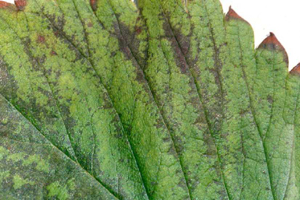Black spot of strawberry
Colletotrichum acutatum
Biology
The fungus can spread throughout the plant, but is found mainly in the base of older petioles. In perennial stands, it overwinters in living or dead plant tissues. Disease outbreak is favored by warm, high-precipitation weather in spring. For spore germination, C. acutatum requires temperatures of at least 15°C and humidity approaching 100%. The fungus finds optimal conditions at temperatures between 22 °C and 28 °C and simultaneous wetness. The longer periods of wetness persist at favorable temperatures, the greater the risk of serious yield losses due to anthracnose.
Damage symptoms

Fruit symptoms on ripe fruit are typical and easily recognizable: small circular brown spots that grow as the disease progresses, turning brown-black in dry weather and sinking deep into the tissue.
C. acutatum can also infect immature berries.
If infection occurs on flowers, they do not develop further but wither and kink.
On petioles and stolons, elongated, dark spots appear that sink into the tissue and are surrounded by a red auricle. In the advanced stage, they encompass the entire tissue. Since the pathogen spreads systemically in the plant, such symptoms on the stolons should be watched out for, especially in the production of planting material.
Spore deposits: Numerous light pink (salmon-colored) spore deposits form on the surface of the infested areas of fruits, petioles and stolons under moist conditions.
Non-specific symptoms: Systemically infected plants may be conspicuous in the field due to their inhibited growth.
Leaf symptoms: Another symptom sometimes observed is small punctate leaf spots (<1mm) occurring mainly along the leaf veins.
Host plants
The pathogen occurs on a wide range of host plants (at least 91 genera in 52 different plant families).
Economically, C. acutatum is most important on strawberries(Fragaria ananassa). In addition, C. acutatum also causes bitter rot on apples, frequently attacks fruit of blueberries and elderberries, and flowers and shoots on citrus plants.
Prevention and control
- Use healthy planting material. C. acutatum can be relatively easily isolated from the base of petioles and detected by the shape and size of spores. Examination of plants prior to planting is recommended.
- Optimization of crop management: to reduce the number of infection periods, good aeration of the crop is essential (single row planting systems, thinning and weed treatment). Timely straw incorporation reduces the spread of spores by water droplets. Furthermore, nitrogen fertilization should be limited. Close picking intervals considerably reduce the risk of fruit infestation.
- Due to the biology of the pathogen, plant protection products have only a partial effect. Their use must be in combination with the specified cultural measures (see list of plant protection products approved in Austria).
- Regular control for symptoms and removal of diseased plants.
- In case of heavy infestation, the field should be turned over. Strawberries should not be replanted for two years.
- Optimization of irrigation strategy: In the warm and dry growing areas of eastern Austria, strawberry cultivation is only possible with irrigation. Optimal in terms of reducing the risk of infection is drip irrigation. If irrigation is necessary, it should be noted that this should not be done at night temperatures above 15 °C, as this would create optimal infection conditions for the fungus. In practice, it has been shown that by switching irrigation to the morning hours, the number of serious disease outbreaks could be reduced, as this ensures faster drying of the strawberry plants.
Specialized information
Microbiology
The conidia are formed in the spore stores (so-called acervuli). These are unseptate, straight and pointed at least at one end (usually both). Their length varies between 8 and 16 µm, the width between 2.5 and 4 µm.
Glomerella acutata occurs predominantly in its secondary fruit form(Colletotrichum acutatum). In addition to C. acutatum , C. fragariae and C. gloeosporioides have also been detected on strawberries, but these are of secondary importance on strawberries in Europe.
Last updated: 05.09.2024
automatically translated